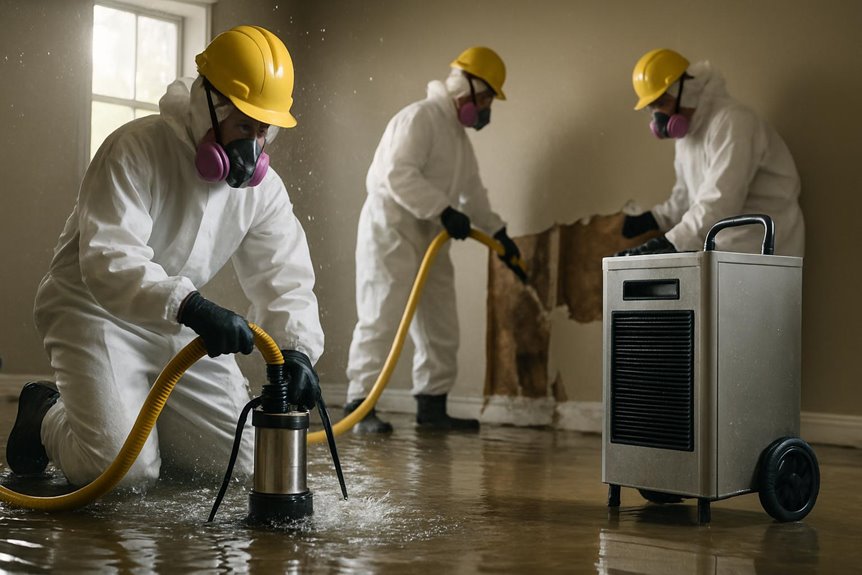Water damage from floods can be devastating, but effective restoration techniques can make a significant difference. Professionals often emphasize the importance of immediate water extraction, thorough drying, and mold prevention strategies. Each step performs a vital function in minimizing damage and ensuring a safe environment. Understanding these methods can help homeowners make informed decisions. What are the specific techniques that can be employed to achieve the best results?
Key Takeaways
- Immediate water extraction using powerful pumps minimizes damage and reduces the risk of mold growth after a flood.
- Effective drying and dehumidification techniques, including fans and moisture measurement, ensure thorough recovery of affected areas.
- Utilizing mold prevention strategies, such as mold-resistant materials and proper ventilation, helps mitigate future growth risks.
- Timely response to water damage incidents effectively minimizes long-term effects on property and health.
- Engaging professional water damage restoration services guarantees expert assistance and a comprehensive approach to recovery.
When water damage strikes, prompt action is essential, as immediate water extraction methods can greatly mitigate further harm.
The first step in addressing a water emergency involves the effective use of pump systems. These systems are designed to remove standing water quickly, minimizing the risk of mold growth and structural damage. Mold remediation is crucial to ensure that any remaining moisture does not lead to future infestations.
Professionals often assess the situation to determine which materials are salvageable, focusing on preserving belongings and vital structures. By utilizing powerful pumps and strategically placed equipment, they can efficiently extract water and prevent extensive damage.
This timely response not only secures the integrity of the property but also offers peace of mind to those affected, promoting a swift recovery towards a sense of normalcy. Additionally, applying temporary drying techniques can significantly enhance the overall remediation process and reduce long-term effects.
Effective Drying and Dehumidification Techniques
After immediate water extraction, the next vital step in the restoration process involves effective drying and dehumidification techniques. These strategies guarantee that moisture is efficiently removed, preventing further damage and fostering a healthy environment. Key methods include optimizing air circulation with fans and dehumidifiers, alongside diligent moisture measurement to assess progress. Implementing essential tips for effective drying and dehumidification techniques empowers homeowners to reclaim their space, guaranteeing a safe and comfortable living environment. Additionally, utilizing water damage restoration services can provide expert assistance for thorough and efficient recovery.
| Technique |
Purpose |
Benefit |
| Air Circulation |
Promotes evaporation |
Reduces drying time |
| Dehumidifiers |
Removes excess moisture |
Prevents mold growth |
| Moisture Measurement |
Tracks humidity levels |
Guarantees thorough drying |
Although water damage can be a significant issue, implementing advanced mold prevention and remediation strategies can greatly mitigate its impact.
Utilizing mold resistant materials, such as specific paints and drywall, is essential in reducing mold growth potential. These materials are designed to withstand moisture, creating a less hospitable environment for mold spores. Additionally, mold resistant products can further enhance these efforts, ensuring a comprehensive approach to mold prevention.
Additionally, effective containment strategies are vital during remediation efforts. By isolating affected areas, professionals can prevent the spread of mold to non-affected spaces, ensuring a thorough cleanup.
Regular assessments of humidity levels, coupled with proper ventilation, can further enhance mold prevention efforts. Furthermore, understanding effective solutions for water damage can help homeowners make informed decisions during the restoration process.
Ultimately, adopting these advanced techniques fosters a healthier living environment and empowers homeowners to take control of their spaces in the face of water damage challenges.
Frequently Asked Questions
How Can I Prevent Future Flooding in My Home?
To prevent future flooding, one should consider effective drainage solutions and install waterproof barriers. These measures not only protect the home but also provide peace of mind, ensuring a dry and secure living environment for all.
What Insurance Coverage Is Needed for Water Damage?
Understanding insurance coverage for water damage is essential. Homeowners should consider flood insurance, ensuring adequate coverage limits to protect against potential financial loss from flooding, providing peace of mind and greater freedom to enjoy their homes.
How Long Does Water Damage Restoration Typically Take?
The restoration timeline for water damage typically spans from a few days to several weeks. Key factors include the drying process, extent of damage, and necessary repairs, ensuring a thorough and effective recovery for affected properties.
Can I Handle Water Damage Restoration Myself?
Considering water damage restoration, one can attempt it personally. Nevertheless, effective water extraction and mold prevention require expertise. Professional assistance often guarantees thoroughness, safeguarding homes against lasting damage and offering peace of mind throughout the process.
What Are the Signs of Hidden Water Damage?
Signs of hidden water damage include damp drywall, which may appear discolored or sagging. Additionally, mold growth can develop in unseen areas, emitting musty odors and posing health risks, highlighting the importance of thorough inspections in any property.
Conclusion
To sum up, effective water damage restoration following a flood relies on three essential techniques: immediate water extraction, thorough drying and dehumidification, and proactive mold prevention strategies. By swiftly removing standing water, optimizing air circulation, and using mold-resistant materials, homeowners can safeguard their living spaces against further damage and health risks. Embracing these methods not only restores the property but also fosters a safe and healthy environment for families to thrive in after a flood.

